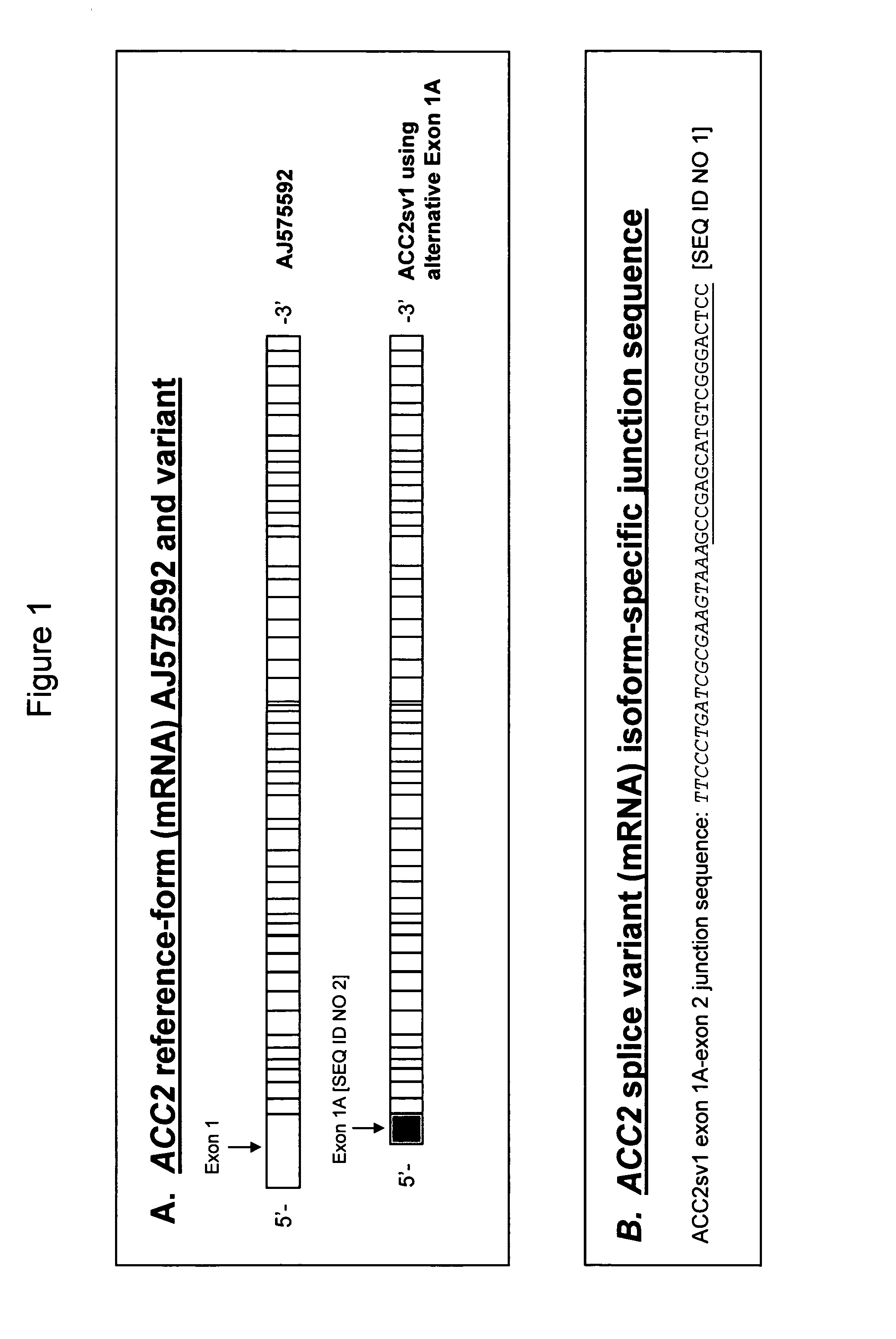Alternatively spliced isoform of acetyl-CoA carboxylase 2 (ACC2)
a technology of acetylcoa carboxylase and isoform, which is applied in the direction of transferases, applications, fused cells, etc., can solve the problems of not supporting the amphiphilic secondary structure of a mitochondrial import protein, the length of the n-terminal region is not uniform, and the basic amino acid is counterbalanced by a comparable number of acidic amino acids
- Summary
- Abstract
- Description
- Claims
- Application Information
AI Technical Summary
Problems solved by technology
Method used
Image
Examples
example 1
Identification of ACC2sv1 Using Genomically Aligned ESTs and RT-PCR
[0139]Using computational and experimental methods, an alternatively spliced isoform of ACC2 was identified. Alternative splicing analysis of the ACC2 gene was performed by aligning expressed sequence tags (EST) to the genomic sequence. Methods for gene structure prediction using genomically aligned ESTs are known in the art and have been described (Mironov et al., 1999, Genome Res. 9:1288–1293; Kan et al., 2001, Genome Res. 11:889–900; Kan et al., 2002, Genome Res. 12:1837–1845; Modrek et al., 2001, Nucleic Acids Res. 29:2850–2859). The mRNA transcript sequence for ACC2 (AJ575592) and ACC2 EST sequences were aligned to the ACC2 genomic sequence using the sim4 alignment program (Florea et al., 1998; Genome Res. 8:967–974), which allows for introns in the genomic sequence and a small number of sequencing errors. The Transcript Assembly Program (TAP, Kan et al., 2001, Genome Res. 11:889–900) was used to predict the gen...
example 2
Cloning of ACC2sv1
[0152]Computational prediction, RT-PCR, and sequencing data indicate that in addition to the normal ACC2 reference mRNA sequence, AJ575592, encoding ACC2 protein, CAE01471, a novel splice variant form of ACC2 mRNA also exists in adipose tissue, skeletal muscle, heart, liver, and testis.
Method 1
[0153]Clones having a nucleotide sequence comprising the splice variant identified in Example 1 (hereafter referred to as ACC2sv1) are isolated using a 5′“forward” ACC2sv1 primer and a 3′“reverse” ACC2sv1 primer, to amplify and clone the entire ACC2sv1 mRNA coding sequences. The 5′“forward” primer is designed for isolation of full length clones corresponding to the ACC2sv1 splice variant and has the nucleotide sequence of 5′ GAGCCCGGTGGGATT GGCCTGCGGGGTGGTCAACATGAGT 3′ (SEQ ID NO 9). The 3′“reverse” primer is designed for isolation of full length clones corresponding to the ACC2sv1 splice variant and has the nucleotide sequence of 5′ TCAGGTGGAGGCCGGGCTGTCCATGGTAGACAG 3′ (SEQ ...
example 3
Real-time Quantitative PCR / TAQman
[0162]To determine the relative mRNA abundances of ACC2sv1 alternatively spliced isoform to the ACC2 reference transcript (AJ575592), a real-time quantitative PCR assay was used. Materials and methods for quantification of splice variants using real-time PCR, using boundary specific probes are known in the art (Kafert et al., 1999 Anal. Biochem. 269:210–213; Vandenbroucke et al, 2001 Nucleic Acids Res. 29:E68–8; Taveau et al., 2002 Anal. Biochem. 305:227–235).
Reverse Transcription
[0163]RNA samples from human heart, liver, adipose tissue, skeletal muscle, and testis (ClonTech, Palo Alto, Calif.) were reverse transcribed using the Applied Biosystems (Foster City, Calif.) TAQman reverse transcription kit N808–0234 following manufacturer's instructions. A 50 μl reaction contained:
[0164]
5μl 10× RT buffer11μl MgCl2 solution10μl dNTP solution2.5μl random hexamer primer1μl RNAse OUT3μl Multiscribe reverse transcriptase1μg of RNAH2O to a final volume of 50 μl...
PUM
| Property | Measurement | Unit |
|---|---|---|
| volume | aaaaa | aaaaa |
| volume | aaaaa | aaaaa |
| volume | aaaaa | aaaaa |
Abstract
Description
Claims
Application Information
 Login to View More
Login to View More - R&D
- Intellectual Property
- Life Sciences
- Materials
- Tech Scout
- Unparalleled Data Quality
- Higher Quality Content
- 60% Fewer Hallucinations
Browse by: Latest US Patents, China's latest patents, Technical Efficacy Thesaurus, Application Domain, Technology Topic, Popular Technical Reports.
© 2025 PatSnap. All rights reserved.Legal|Privacy policy|Modern Slavery Act Transparency Statement|Sitemap|About US| Contact US: help@patsnap.com

